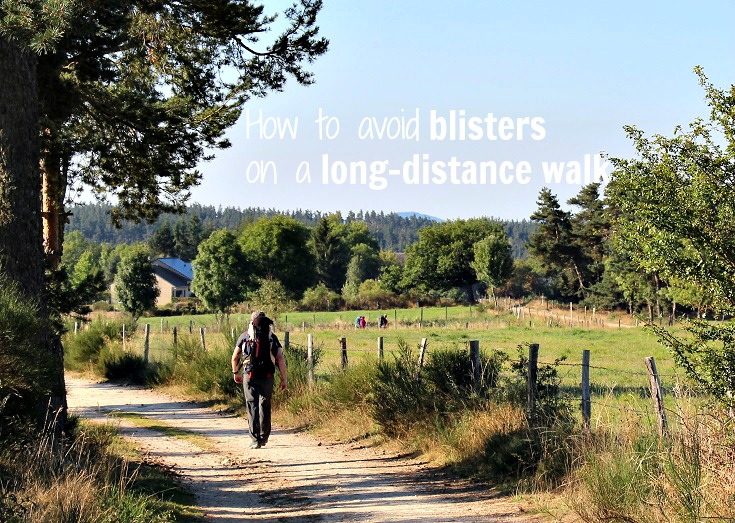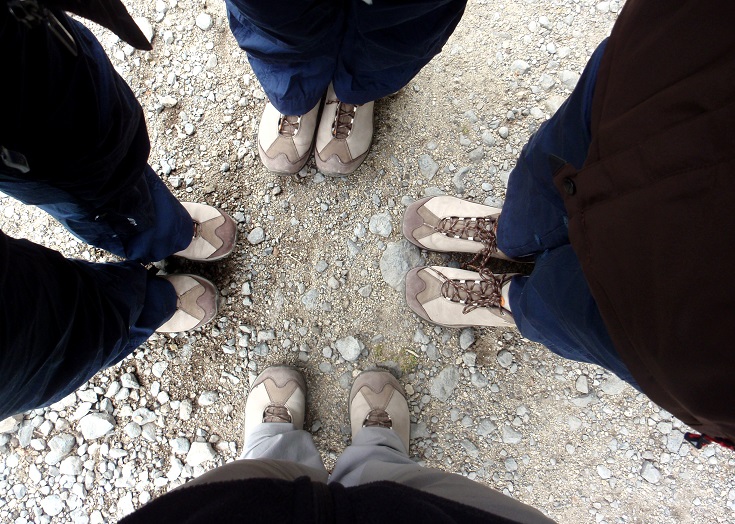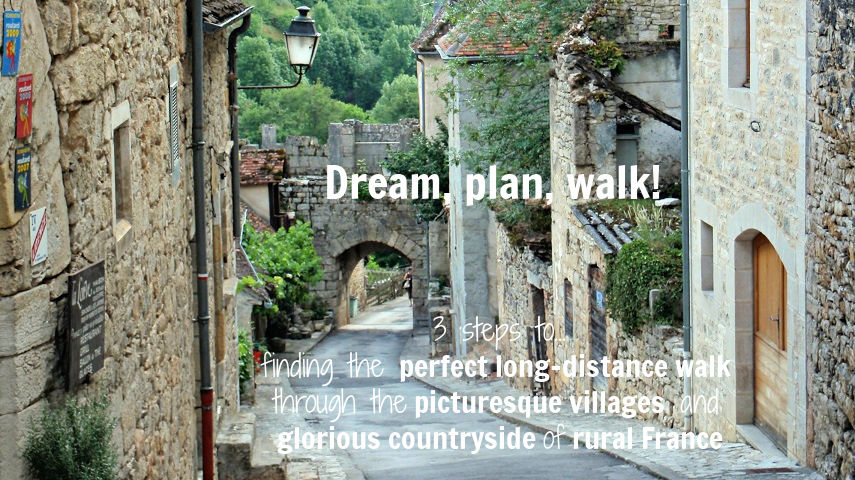
(First published June 2016, last updated July 2025)
When I first began long-distance walking, I thought blisters were a necessary and unavoidable evil.
As someone who often walks 15—20 kilometres (10—12 miles) each day on a regular holiday, I’ve always suffered from tiny water blisters on the balls of my feet. Each night, I’d slice them open, release the liquid and cover them with a large band-aid before starting over the next morning. The little bit of padding in a band-aid (maybe two) was all I needed to feel OK and do it again another day.
Many years ago, I spent three weeks walking in Burgundy before heading back to Paris for a week with friends and another week walking part of the Chemin de Saint-Jacques du-Puy. By the time I reached Paris, my feet were a bit messy. By the time we finished the week of walking, my feet were too damaged to look at! Each afternoon, as I stopped walking, the blood pooled in my feet and created a vacuum in my boots. I’d have to lie with my feet in the air until the blood dispersed and I could get my boots off.

Despite all of us wearing the exact same très confortable et sensible Merrill walking shoes, my friends survived relatively unscathed! And ironically (but for reasons easily explained by my podiatrist), my feet hurt the LEAST when I was walking and the most when we stopped for lunch!
Preparation and preventative measures
A visit to the podiatrist when I returned home revealed some flaws in my walking technique. By lifting my heel too early, the muscles in my lower calf were not being used—they were locked tight and it was difficult for blood to be pumped back up away from my feet. (As I walked, the pressure on the balls of my feet provided some mechanical pumping action, but once I stopped, gravity took its toll and the blood slowly pooled.)
He suggested a number of strategies to overcome these problems—
(1) Calf massage and exercises to loosen the calf muscles
(2) Rubbing the soles of my feet with methylated spirits to toughen them up
(3) Wearing compression socks while walking to provide support and stop blood pooling in my feet
The improvement in my feet on the next walk was enormous!
I had rubbed the methylated spirits on my feet with a cotton pad and so I developed some small blisters in the places I missed—between my toes, under my toes…and I dislodged a toenail because I hadn’t allowed for the compression sock providing less padding inside the shoe.
Another visit and a few tweaks from the podiatrist on my return and a new plan—
(1) Calf massage and exercises to loosen the calf muscles
(2) Spraying the soles of my feet with methylated spirits to get into all the little nooks and crannies
(3) Wearing socks with individual toes and toeless compression stockings while walking (although I found the toeless stockings trapped fluid in my feet so I only wore them once).
I am delighted to say I had NO problems on my next walk, and only a few minor problems since then!!
TIP—A Scottish lady we met while walking the Chemin de Stevenson recommended Compeed gel patches. Available in several sizes, they provide padding and waterproof protection to blisters and should be left on for several days (even in the shower) while the raw skin heals. I’ll be adding a few to my first aid kit for next time. (I also figure this works like the umbrella principle—most things I carry will not be needed!)
I’m not suggesting for a moment that my blister solutions will be the answers to your problems, but I have found that often the best solutions are found in unlikely places. If you ask ten other walkers what works well for them, you’ll receive ten different suggestions. All are worth a try to find the one that’s right for you. Many people swear by—
(1) Wearing a shoe that is half to one size too big. This allows the foot plenty of room to move and helps to avoid friction blisters caused by rubbing. (This does not work well for me. As my foot slides forward and taps the front of my shoe, the constant hammering usually dislodges a toenail after a few days of walking. I believe this problem can be solved by lacing your shoes in a certain way, but I’ve yet to find the magic formula.)
(2) Carrying thick and thin socks and wearing a combination of the two that provides a cosy, but not tight, fit inside your shoe. If your feet swell as the day heats up, one pair of socks can be removed.
(3) Wearing socks made from merino wool which breaths well and draws moisture away from your foot.
(4) Applying a generous dollop of NOK cream to your feet will keep them slippery inside your shoe, which also helps to avoid friction blisters caused by rubbing. (NOK cream is readily available in pharmacies in France, but Vaseline will work almost as well).
The importance of good shoes
It goes without saying that well fitted, comfortable, well worn-in walking shoes are of utmost importance, but again, if you ask ten other walkers for their best recommendation, you’ll receive ten different suggestions.
Different trail surfaces and conditions are best served by different types of shoes, but knowing in advance what you’ll encounter is often not possible. Sometimes it’s best to research as much as you can but assume you’ll encounter some dirt or gravel paths, some rocky sections, some mud and some road walking. No matter what shoe you choose, it’s likely that, at best, you’ll love it for most of the walk and consider it completely unsuitable for, hopefully, only a small part. Points to consider include—
Hiking shoes or trail runners? Trail runners provide more cushioning and are usually more comfortable for most surfaces, but on rocky sections of the path a hiking shoe will provide better grip and protection. Hiking shoes will last well over a thousand kilometres (600 miles), but trail runners will need to be replaced every 300 – 400 kilometres (200 – 250 miles).
Boots or shoes? A high ankle can feel supportive or constrictive. Choose what’s best for you.
Waterproofing? A truly waterproof shoe is made from materials that water, and air, cannot penetrate. If water gets into waterproof shoes from the gap around your ankle, such as stepping in a puddle or really heavy rain, they take forever to dry out, sometimes longer than overnight unless you have access to a heater and newspaper to stuff them with. And while these are easy solutions to say you’ll use, the reality is that if six – ten people arrive at the end of the day all looking for newspaper and a space on top of the heater, there may not be enough to go around. If you have to walk the next day in wet shoes, truly waterproof shoes will stay wet and be uncomfortable, whereas breathable shoes will dry out over the day.
Many shoes claim to be waterproof but are, in fact, water-resistant, and this is a good compromise. They may still get quite wet if you step in a puddle or get caught in a downpour, but they will dry out quickly.
What do I wear? I currently have a pair each of Merrill Moab 2 Vents (which provide a stable base on rocky trails such as the Chemin de Saint-Jacques), Altra Lone Peaks (which offer a more cushioned walk on the Chemin de Stevenson and other shorter walks) and Teva Tirra sandals (which are perfect for road walking and sturdy paths—and for wearing to dinner). The best solution for me is to take either the Merrills or the Altras and to switch them out with the Tevas as the trail conditions change throughout the day.
If past experience has taught you that blisters are likely to form as you walk, invest in a good pair of shoes and find a podiatrist who will assess your walking technique at least six weeks before you leave, giving you plenty of time to implement and prepare.
You’ll find many more practical tips for long-distance walking here.

